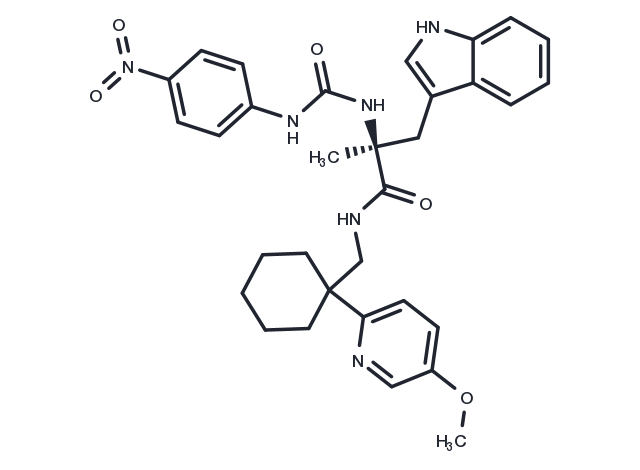store under nitrogen
Powder: -20°C for 3 years | In solvent: -80°C for 1 year

PD176252 is a potent BB1 and BB2 antagonist with inhibitory effects on BB1 and BB2 receptors.PD176252 acts as a small molecule GRPR inhibitor and FPR1/FPR2 agonist to inhibit the growth and proliferation of a variety of cancer cells.

| Pack Size | Availability | Price/USD | Quantity |
|---|---|---|---|
| 5 mg | In stock | Inquiry | |
| 50 mg | In stock | Inquiry | |
| 1 mL * 10 mM (in DMSO) | In stock | $ 80.00 |

| Description | PD176252 is a potent BB1 and BB2 antagonist with inhibitory effects on BB1 and BB2 receptors.PD176252 acts as a small molecule GRPR inhibitor and FPR1/FPR2 agonist to inhibit the growth and proliferation of a variety of cancer cells. |
| Targets&IC50 | FPR1:0.31 μM (EC50), BB2 receptor:16 nM (Rat), BB1 receptor:0.66 nM (Ki, Rat), FPR:0.72±0.21 μM (EC50, human), FPR2:0.66 μM (EC50), BB1 receptor:0.17 nM (Ki, Human), BB2 receptor:1 nM (Ki, Human) |
| In vitro | PD176252 is a potent antagonist of neuromedin-B preferring (BB1) and gastrin-releasing peptide-preferring (BB2) receptors with Kis of 0.17 nM and 1 nM for human BB1 and BB2 receptors, and 0.66 nM and 16 nM for Rat BB1 and BB2 receptors, respectively. In CHO cells expressing human BB1 or BB2 receptors, PD176252 inhibits acidification responses to neuromedin-B or neuromedin-C with appKBs of 4.0 nM or 13 nM. It also blocks bombesin-evoked increases in intracellular calcium levels in CHO cells stably expressing human BB1 or BB2 receptors, with appKBs of 2.3 nM and 36 nM, respectively.PD176252 is additionally an agonist of N-Formyl peptide receptor1/2 (FPR1/FPR2), with EC50s of 0.31 and 0.66 μM in HL-60 cells. It activates Ca2+ mobilization in HL-60 cells transfected with human FPRs (EC50, 0.72 ± 0.21 μM)[2]. PD176252 shows little specific 125I-gastrin releasing peptide binding to NCI-H345 cells at 1 nM, suppressing almost all specific bindings at 1000 nM, with an IC50 of 30 nM. Furthermore, PD176252 (10, 30 μM) significantly inhibits the growth of NCI-H345 or H1299 cells, with IC50s of 7 and 5 μM[1]. |
| In vivo | Orally administered PD176252 (1, 10 μg) potently inhibits the growth and proliferation of NCI-H1299 xenografts in nude mice[1]. |
| Molecular Weight | 584.67 |
| Formula | C32H36N6O5 |
| CAS No. | 204067-01-6 |
store under nitrogen
Powder: -20°C for 3 years | In solvent: -80°C for 1 year
DMSO: 100 mg/mL(171.04 mM), Sonication is recommended.
You can also refer to dose conversion for different animals. More
bottom
Please see Inhibitor Handling Instructions for more frequently ask questions. Topics include: how to prepare stock solutions, how to store products, and cautions on cell-based assays & animal experiments, etc.
PD176252 204067-01-6 GPCR/G Protein Bombesin Receptor PD-176252 PD 176252 inhibitor inhibit
